This guide covers the Island Peak variation of the Everest Base Camp Trek by providing a detailed itinerary of the climb and how it fits into the base camp trek schedule.
We also answer various questions on difficulty, best time to climb, insurance, packing list and more.
The Everest Base Camp and Island Peak Trek is a significantly more challenging alternative to the classic, up and down Everest Base Camp Trek. The Island Peak variation adds on an additional 5 days, spent tackling one of the great trekking peaks in the area – Island Peak or Imja Tse as it is called by the locals.
The trek follows the route of the classic Everest Base Camp Trek for the first 10 days as you head up north-east through the Khumbu Valley on your way to the base camp on the south side of Everest. You will pass through various Sherpa villages and stay in quaint tea houses in Phadking, Namche Bazaar, Dingboche, Tengboche and Gorak Shep as you gradually gain altitude.
After visiting Everest Base Camp and experiencing the lively atmosphere and buzz of potential summiteers of Everest, you will have the chance to hike the nearby peak of Kala Patthar. Known as the iconic viewpoint of Everest, Kala Patthar provides unmatched views of the summit of Everest as well as the surrounding peaks of Nuptse and Lhotse.
The Island Peak variation follows the classic route as you descend back down to Dingboche before parting with the crowds and heading east up the Imja Khola Valley towards Chukkung – the final stop before Island Peak.
The ascent of Island Peak is challenging and will requires use of crampons and an ice axe to navigate the glaciers and ice headwall that characterises the climb. Some prior mountaineering experience is recommended before you take on Island Peak, and a good level of fitness is mandatory!
Once at the top, you will find that all the hard work was worth it as you will have wonderful panoramic vistas of Ama Dablam, Lhotse and Mera Peak. The descent is also a long affair, but once completed, the return journey to Lukla is fast and easy.
Get a Trek Quote
We do not sell tours, we simply provide impartial advice. If you would like an exact quote from our recommended tour operator click Get a Quote.
Island Peak Climb
Regional Map
The Island Peak climb takes place within the Everest or Khumbu regional of Nepal, as indicated by the orange block on the map below. The starting point of the adventure, Lukla, is clearly visible in the lower portion of the region. From here, the route heads north to the south side base camp of Everest before moving east to Island Peak which is located just south of the peak of Lhotse.

Island Peak Trekking Map
This diagrammatic map outlines the route to Everest Base Camp and Island Peak from the starting point of Lukla. The trek heads north through the towns of Phadking, Namche Bazar, Tengboche, Pheriche and Lobuche before reaching the highest inhabited town of Gorak Shep.
Gorak Shep will act as your base while you trek up to Everest Base Camp and then Kala Patthar the following day. The route then descends on the same path down to Pheriche where it veers east through Dingboche and Chukkung as you make your way to Island Peak.
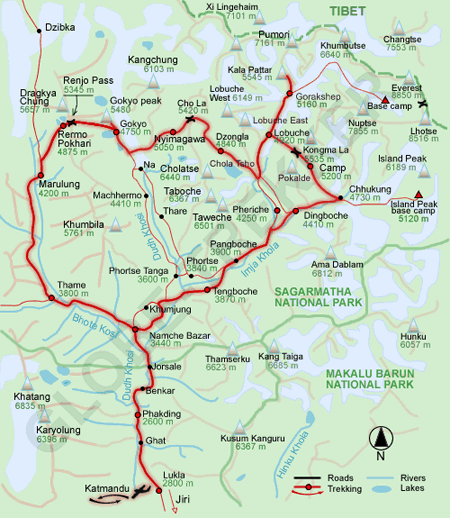
The return to Lukla from Island Peak is relatively quick as you descend through Chukkung, Dingboche, Tengboche and Namche Bazar before reaching Lukla where your flight will await you.
Recommended Guidebooks
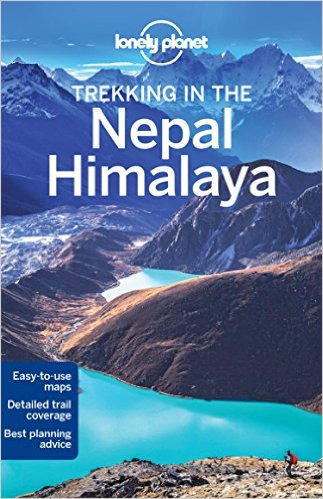
We recommend taking a guide book such as the Lonely Planet Trekking in Nepal Himalaya guide, as it is regularly updated and provides information on a variety of treks in the region. It makes great background reading if you want to learn a bit more about the region in which you are going to be spending the next 3 weeks.
In addition to this guidebook we also highly recommend Mark Horrell’s entertaining book: Islands in the Snow: Climbing Nepal’s Trekking Peaks, which provides loads of pragmatic advice on the Island and Mera Peak climb, and is also super fun to read.
In terms of a map we recommend Nepa Maps Everest Region map
Detailed Itinerary
As with all treks in Nepal, your very first port of call will be in the capital city of Kathmandu.
From here, a short but very memorable flight will take you to the small village of Lukla, where the actual trekking begins. The trip lasts a total of 20 days, although only 16 of those days will be spent trekking. 3 days of travelling, a day or so of acclimatisation as well as some contingency days make up the rest of the allotted time.
If you don’t want to fly into Lukla, there is the option of following the early pioneers by trekking from Jiri to Lukla – an additional 5-days trekking through dense forests. For more information on this variation, read our route guide on the Jiri to Everest Base Camp Trek.
Days 1 – 10: Standard EBC Trek Route
These days will follow the exact same itinerary of the classic Everest Base Camp Trek, which you can view here.
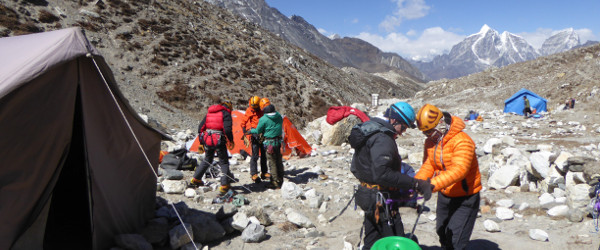
Day 11: Dingboche to Chukkung
After spending the night in Dingboche, you will trek to Chukkung through the Imja Valley. The day is long, but the trek is easy and once you reach Chukkung you will be lodged at one of two tea houses that both have awesome food – a luxury in the Himalayas! There is a gear rental shop in Chukkung where you can hire all essential items, like hard shell boots, crampons, harness, helmet, ice axe and jumar.
Day 12: Chukkung to Island Peak Base Camp
Another easy day of hiking will take you to the Island Peak Base Camp – your base for the summit attempt. It is a gradual ascent, but still try to take it easy and rest your body for the summit climb in the next few days.
Day 13: Island Peak B.C. to High Camp
A small ascent to Island Peak High Camp – only 200m above base camp – is all this day entails. The climb is short, but at this altitude you will feel every inch of ascent! Spending the night at high camp makes the summit push vastly easier, although you will need porters to carry all the supplies and camping equipment up to the camp. There is no access to water at high camp so you will need to bring extra supplies.
Day 14: Summit Day
A very early start to summit day (waking up at 1am) is needed so that the peak can be reached by noon. Strong winds in the afternoon can potentially derail a summit attempt.
You will initially cross very rocky and icy terrain (watch your footing!) as you leave high camp, but the ground will soon turn into a glacier, this is the crampon point. Here you will don your hard shell boots and put on your crampons to trek to the summit headwall. Depending on the season and on changes in climate, you will likely have to cross one or two crevasses using a ladder and ropes.
The headwall before the summit is a 120m vertical ascent at a gradient of roughly 45 degrees. The ice is often very fragmented so you will make use of an ascender and jumar on fixed ropes (the use of which can be learnt on any basic winter mountaineering course).
The summit of Island Peak is particularly small, about the size of a big round dining room table. A max of 4-5 people can fit on the summit at any given time. Once the summit has been reached and you have taken in all the wonderful views, you will descend back to base camp for the night. Please descend carefully as it is here that most accidents occur.
Day 15: Contingency Day
This day is usually used as a contingency day in the event of bad weather preventing a summit attempt. If the summit attempt the day before was successful, you will proceed to descend.
Day 16: Island Base Camp to Pangboche / Chukkung
An easy descent to the scenic village of Pangboche will see you pass through various Sherpa villages over the course of 5 hours.
Day 17: Pangboche to Namche Bazaar
A longer day’s trekking will take you through the town of Tengboche, where you will have lunch before descending further onto Namche Bazaar. Head straight to the french bakery in Namche for some much-needed coffee and a pastry or two!
Day 18: Namche to Lukla
The last day of trekking takes you back down the Dudh Koshi valley to Lukla where you will spend a night – celebrations will be on the cards!
Day 19: Return to Kathamandu
Weather permitting, an early morning flight will take you back to Kathmandu where you can explore the country of Nepal for one last time.
Day 20: Depart Nepal
Departure day means boarding your flight back home where you can tell all of your amazing adventure!
Get a Trek Quote
We do not sell tours, we simply provide impartial advice. If you would like an exact quote from our recommended tour operator click Get a Quote.
Altitude Profile
This graph shows the ascent profile for the Island Peak challenge. It is easy to see how this variation trek is more difficult than the classic trek because of the sharp spike in altitude and technical climbing element of Island Peak.

Island Peak FAQ
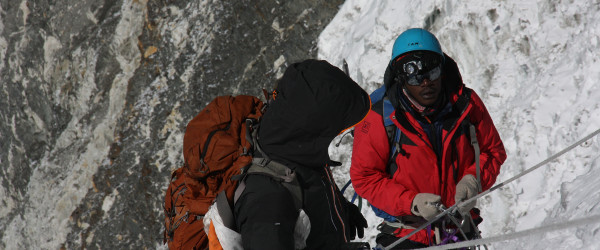
How much does Island Peak Cost?
An experienced and quality western tour operator will likely charge in the region of £2,500-£3,500 for an all-inclusive package. For a breakdown of costs including flights of a general base camp trek (not Island Peak), read our article on Everest Base Camp costs.
When is the best time to climb Island Peak?
February-May and September-October are the best months to hike in the region. They fall just outside of the peak summer months that are associated with the monsoon season. These months are also not that cold and are consistently dry and stable – providing great trekking conditions.
Do I need a visa / permit for Island Peak?
Yes, all visitors to Nepal (excluding Indian citizens) will need a visa. A 30-day multi entry visa will be perfect for a trip of this length. One of these will cost you US$ 40.
As Island Peak is a Group B Trekking Peak, a permit for four people will cost in the region of US$340. This is required in addition to a permit for the Sagarmatha National Park as well as a Trekkers Information Management System (TIMS) card. These will set you back roughly US$100.
A deposit on garbage may also be required.
Will I get altitude sickness?
The route of the trek and the trek-specific itinerary ensure that enough time is allocated for proper acclimatization. By the time you reach the high point of Island Peak, you would have already spent 2 weeks at high altitudes such as those at Everest Base Camp and Kala Patthar. This will mean you should be adequately acclimatised for the summit of the peak.
Despite this, altitude sickness can affect anyone regardless of age or fitness level so it is imperative that you read up a bit more about the sickness, its symptoms and acclimatization in general. Our detailed article is a good starting point.
Get a Trek Quote
We do not sell tours, we simply provide impartial advice. If you would like an exact quote from our recommended tour operator click Get a Quote.
What gear should I pack for Island Peak?
The packing list for a trek of this duration is very extensive, so we have compiled all the clothing and equipment you will need into one single article which you can read here. We have also included some of our recommendations based on past experience of trekking in the area. Please note, our packing list does not include the technical items you need for Island Peak, these are:
- Ice Axe – we recommend Black Diamond
- High altitude mountaineering boots, we recommend Scarpa Phantom 6000s or La Sportiva
- Crampons
- Helmet – we recommend Black Diamond helmets
- Harness, ascender and descender, locking and non-locking carabiners and prussik chord
What insurance do I need for Island Peak?
Yes. Trekking at altitude in Nepal comes with various risks of injury and sickness, so a proper insurance policy is vital. The risk is even greater on the Island Peak Trek as you will be reaching altitudes of above 6,000m.
Most insurance companies will not offer standard travel insurance for treks above 6,000m so we recommend contacting your local mountaineering association in your country for more advice on which insurance policy to take out.
For more information on travel insurance when trekking in the Everest region, read our detailed article here.
Route Variations
Gokyo Lakes Trek
One of the more popular variations of the Everest Base Camp Trek, the Gokyo Lakes Trek, also starts at Lukla and follows the classic base camp trek to Namche Bazaar where it forks north-west.
The trek proceeds through the towns of Dole and Machhermo before reaching the stunning Gokyo Lakes. From there you ascend to the peak of Gokyo Ri in the north, before traversing Cho La Pass and re-joining the classic trek at Lobuche.
The detour adds 2/3 days onto the trek but provides the wonderful opportunity to summit a peak while also avoiding some of the busier parts of the trek.
Jiri to Everest Base Camp
This variation of the classic trek offers an alternative to flying into to Lukla from Kathmandu to start the trek. The Jiri variation starts with an 8-hour bus ride from Kathmandu to Jiri, where the trek begins.
The variation adds an extra 5/6 days onto the trip as you trek through the Solu-Khumbu region and make your way past Lukla, where the trek then follows the same route as the classic Everest Base Camp Trek.
It involves a scenic, yet very long, bus ride as well as a lot more exposure to the Tibetan and Sherpa cultures. Expect to trek through more forests and streams as you start at the relatively low altitude of 1,800m and work your way up to Lukla and beyond.
Three Passes Trek
The Three Passes Trek is a tougher variation than the classic Everest Base Camp Trek because it involves crossing three very high passes as well as summiting some walking peaks which are not included on the classic trek.
The variation starts by following the classic trek from Lukla to Namche Bazar before veering west towards Thame and the remote Nangpa Valley. The first of the three passes encountered is the Renjo La, where you will be afforded magnificent views of Everest before descending to the idyllic Gokyo lakes.
The next pass, Cho La, involves walking up a fairly steep and icy trail before reaching a small glacier at the top. From here, you descend and re-join the main base camp trek where you summit Kala Patthar – the iconic viewpoint. You continue onto base camp itself before descending to Lobuche.
You then head east over the third pass of Kongma La and continue onwards to summit the third peak of Chukking Ri. Once again you will have amazing views of the surrounding peaks that you would not get to see on the classic trek. The circuit is completed by returning to Lukla through the main Everest trail.

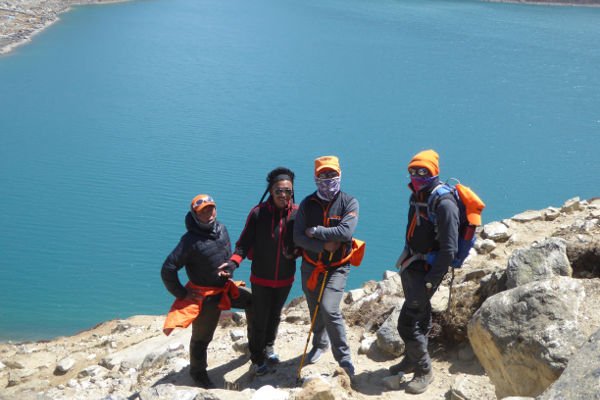


Thank you so much for the most valuable information for the trek. I’m planning to trek EBC as well as Island peak without a guide. Do you think it is possible to climb summit of Island peak without a guide. Please advise.
Thanks,
Uday
Hi Uday, to climb Island Peak you will need a permit. I don’t believe you need a guide but I would seriously consider taking one unless you are an experienced mountaineer.
Hi Mark, thanks for the great website with a lot of valuable info.
I want to hike EBC in April, wanna do Gokyo lake variation and after arriving to actual EBC and hiking Kata Patthar I want to do Island Peak. And here comes my question. Can I do it without previous booking with any of the agencies(I do not have spare 3000£)? I mean, can I rent a guide in Chukkung who would go to summit with me, together with renting my gear? Do you have any idea how much would it cost? Thank you.
Hi Mark, yes, this is possible. I can’t guarantee you will find a guide in Chukkung but generally there are guides in and around the area who can help you climb Island Peak. Again, there’s no guarantee that there skills / qualifications will be up to standard. In terms of gear, there is a great rental shop in Chukkung where you can hire pretty much everything you need for Island Peak. Please note, the Island Peak climb has got a lot more technical in recent years, with a number of crevasse crossings. When I climbed it in 2016 the route involved two small ladder crossings, but this 2018 interview with Alan Arnette gives a good overview into the climb today: https://www.mountainiq.com/alan-arnette-interview-climbing-island-peak/
Thank you so much for such an informative series of articles , which i found very beneficial for my upcoming island peak trek next April.
Just a comment that in the article:-
Acclimatisation And Altitude Sickness Guide For Everest Base Camp Trek
Would there be a reversal of the names on the HACE and the HAPE definitions.
Thank you
Conor
Thanks Conor, yes, the titles were mixed up.